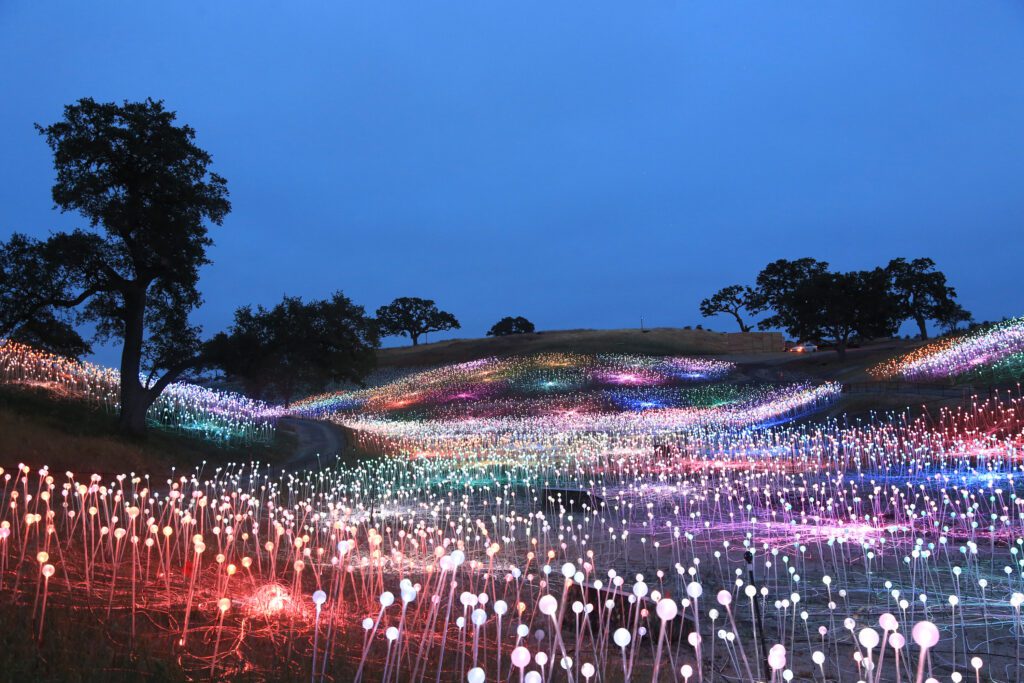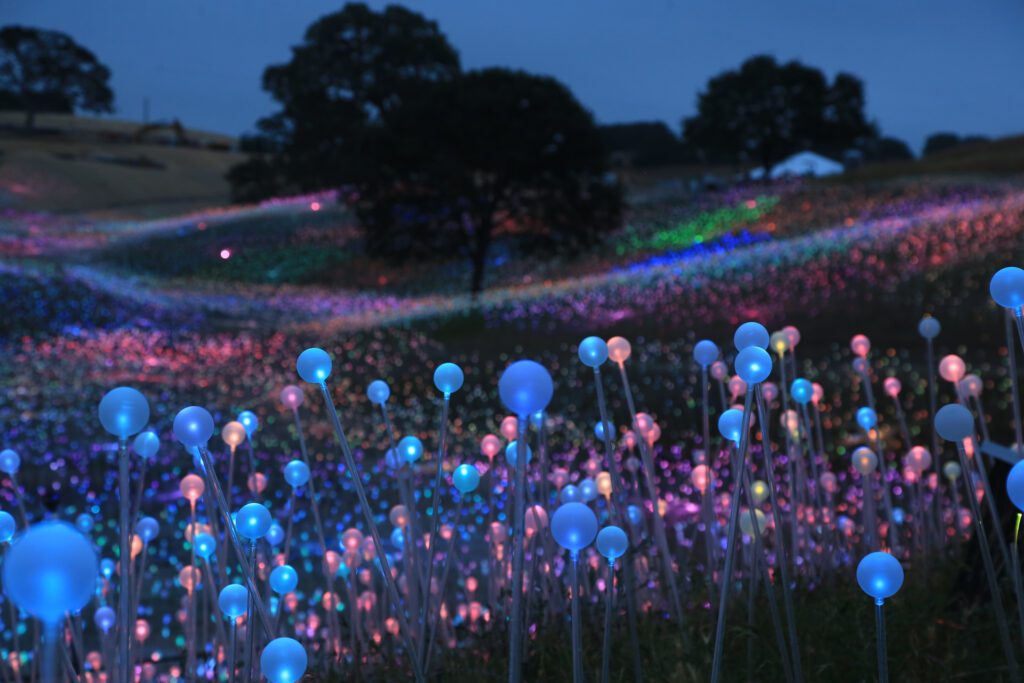The acclaimed British light artist brings a brilliantly beautiful, hidden high-tech garden to the hills of Central California.
By day, thousands of milky spheres dot a secluded stretch of land off of Highway 46. But as night falls, these rolling hills northeast of downtown Paso Robles begin to glow, transforming into a brilliant 15-acre valley of undulating lights. Visitors have likened it to Pandora, the fantastical alien world in James Cameron’s epic science fiction film, Avatar. Others rave about the captivating result of merging technology and nature—as if a Kusama installation collided with Keukenhof. This collection of nearly 60,000 stemmed spheres lit by fiber-optics and gently illuminating the landscape in subtle blooms of morphing color is Bruce Munro: Field of Light at Sensorio.

Born in London, artist Bruce Munro is acclaimed for his large-scale, immersive, light-based installations utilizing thousands of individual components. “I discovered light as a medium first in my professional career outside fine art. I had been a painter but needed to earn a living, and I found myself doing that in Australia, manufacturing display signs using a glowing, ultraviolet plastic the properties of which I just loved,” Munro explains. “In my early forties, I began making personal things using repurposed manufacturing components and light. I realized that I had always been striving to be so different, to make my art different; but starting then, I began looking for shared experience.”
Munro turned to the sketchbook journals he had been keeping since childhood to draw inspiration from. They captured years of his responses to music, literature, science, and the world around him. “I had recorded moments and memories of feeling at one with the world—and I realized that could be expressed by light. Our experiences of being connected to the world in its largest sense, of being part of an essential pattern, became my subject matter.” His recurring motif is the use of light on an environmental scale in order to evoke an emotional response in observers.
Field of Light at Sensorio recently celebrated its 1-year anniversary since opening in May 2019, celebrating its feat of capturing an international audience of more than 145,000 visitors from 41 countries. Although the exhibit was forced to close its doors due to COVID-19, it was granted permission by the Public Health Director of San Luis Obispo County to re-open June 12, 2020. “As Sensorio was designated an outdoor museum, we felt it was important to reopen,” said Executive Director Tracy Strann. “Sensorio offers a safe, peaceful, meditative, and inspirational experience.”

Speaking about why art is more important now than ever before, Munro chimes in: “Art in nature inspires and connects us—gardens are the museums of the future. The simple truth is that we should cherish and support each other at times like this.” At home in Wiltshire, Munro’s current project entails stringing together 120,000 CDs along a mile-long footpath to honor United Kingdom National Health Service workers and volunteers. Titled Ribbon of Light, the installation serves as a glimmering reminder of their selflessness and dedication during the pandemic.
Field of Light at Sensorio utilizes an array of stemmed spheres lit by fiber-optics over 15 acres of rolling hills through which visitors can stroll. Larger in size than any other Munro exhibition internationally, this immersive exhibit is also Munro’s first American installation powered entirely by solar energy. For many lovebirds, the beautiful new Central California destination became a popular setting for popping the question, with staff reporting more than 30 marriage proposals on the grounds to date.
Prior to Field of Light at Sensorio in Paso Robles, Munro visited California in 2018 to install his first public West Coast exhibition—Bruce Munro at Montalvo: Stories in Light—at the Montalvo Arts Center in Saratoga. The world premiere exhibition illuminated the center’s lawns, gardens, terraces, and historic structures with 10 light-based works inspired by the artist’s readings of C.S. Lewis’ acclaimed The Chronicles of Narnia book series. Ranging in scale from enormous and immersive to intimate displays, the exhibition utilized hundreds of thousands of bespoke components to transform Montalvo into a breathtaking spectacle of illumination.
When Munro was invited to Montalvo in 2016 to consider its property as a site for a new exhibition, he experienced a profound moment he calls “powerful literary connection.” He was immediately struck by the grounds’ resemblance to a house and garden from The Voyage of the Dawn Treader, the third book in C.S. Lewis’ much beloved series of novels. Inspired, Munro transformed Montalvo’s Great Lawn into a sea of lily pads created from over 4,000 illuminated stems in the “Silver Sea” exhibit, named after Narnia’s flowing freshwater ocean. He also planted a flamboyance of 1,000 flamingos on Montalvo’s Garden Terrace, illuminated in sunset hues and paying tribute to “Ramandu’s Table.” On Montalvo’s Garden Theatre stage, the massive “Reepicheep’s Wave”—made of 15,000 vacuum cast mussel shells formed from ocean plastics and suspended on illuminated optical fibers—represented a visual metaphor employed by Lewis in the last chapter of The Voyage of the Dawn Treader.
Stories in Light invited viewers to contemplate a world larger and more mysterious than their own existences. “This extraordinary exhibition fulfilled our mission to use our beautiful, historic property in innovative ways to engage the community in the creative process,” said Montalvo Executive Director Angela McConnell. Featuring the largest number of works by Munro ever on public display at a single venue, the exhibition drew 35,000 visitors from across the country by the time it closed March 17, 2019.

Shortly before dusk in Paso Robles, thousands of stemmed orbs begin glowing softly as far as the eye can see. A hush settles over the crowd, who turn around slowly, watching in wonder as the lights envelop them. The silence is permeated only by murmurs of delight, creating a soft hum throughout the grounds each night. “It seems to be a natural response to the exquisite beauty of the entire experience,” says Strann, witnessing the tranquility that blankets the grounds as the installation comes to life. During these times of uncertainty and darkness, it seems it is more important than ever to reestablish our connection with nature—and the light.
